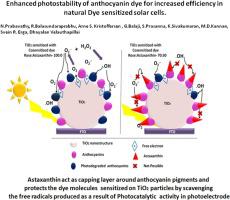Optik ( IF 3.1 ) Pub Date : 2020-11-22 , DOI: 10.1016/j.ijleo.2020.166053 Prabavathy N. , Balasundaraprabhu R. , Arne S. Kristoffersen , Balaji G. , Prasanna S. , Sivakumaran K. , Kannan M.D. , Svein R. Erga , Dhayalan Velauthapillai

|
To improve the performance of anthocyanin based dye sensitized solar cells (DSSC), it is essential to passivate the photocatalytic activity (PCA) induced by photoelectrode that activates dye degradation. In the present work, red color astaxanthin pigments extracted from green color Haematococcus Pluvialis is used as a cosensitizer with anthocyanins extracted from rose petals to scavenge the free radicals (antioxidant) generated as a result of PCA, thereby minimizing photodegradation of anthocyanins by 60 %. Herein we have hydrothermally prepared rutile TiO2 nanostructures that appear as distorted TiO2 nanospheres (NS) and the cosensitizer ratio is optimized for maximum astaxanthin efficacy. The least molecular interaction of astaxanthin with anthocyanins as measured from fluorescence life time studies suggest that astaxanthin encircle anthocyanins as a shield against photodegradation. The structure of DSSC with Fluorine doped Tin Oxide/TiO2 NS/algal buffer layer / cosensitized dye (Rose:Astaxanthin - 70 :30) /iodine-iodide/ Pt /glass shows a higher efficiency of 2.82 %. Relatively higher efficiency of 3.31 % was also observed for DSSC with 3% Ca doped TiO2 nanorods as photoelectrode using cosensitized dye as sensitizer due to the passivation of PCA by the astaxanthins and the photoelectrode by itself.
中文翻译:

花青素染料的光稳定性增强,可提高天然染料敏化太阳能电池的效率
为了提高基于花色苷的染料敏化太阳能电池(DSSC)的性能,必须钝化由激活染料降解的光电极诱导的光催化活性(PCA)。在目前的工作中,将从绿色血球菌(Pluvialis)提取的红色虾青素颜料与从玫瑰花瓣中提取的花青素一起用作增敏剂,以清除PCA产生的自由基(抗氧化剂),从而将花青素的光降解最小化60%。在这里,我们已经水热制备了金红石型TiO 2纳米结构,表现为扭曲的TiO 2。纳米球(NS)和共敏化剂比例已得到优化,以实现最大的虾青素功效。从荧光寿命研究中测得,虾青素与花青素的最小分子相互作用表明,虾青素包围花青素,以防止光降解。具有氟掺杂的氧化锡/ TiO 2 NS /藻类缓冲层/共敏染料(Rose:虾青素-70:30)/碘化碘/ Pt /玻璃的DSSC结构显示出2.82%的更高效率。使用共增感染料作为敏化剂的3%Ca掺杂的TiO 2纳米棒作为光电极的DSSC,由于虾青素和光电极本身对PCA的钝化,还观察到相对较高的效率,为3.31%。



























 京公网安备 11010802027423号
京公网安备 11010802027423号